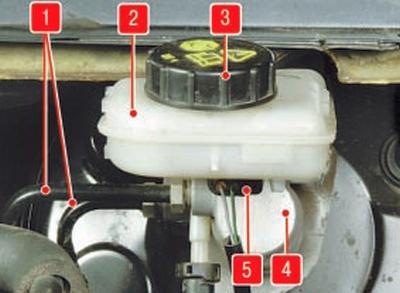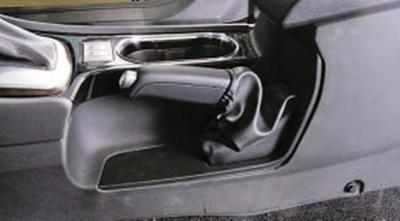The working system is double-circuit, with a diagonal connection of the brake mechanisms of the front and rear wheels. One hydraulic drive circuit ensures the operation of the right front and left rear brake mechanisms, the other - the left front and right rear.
If one of the circuits of the working brake system fails, the second circuit is used, which ensures that the car stops with sufficient efficiency.
A vacuum booster is included in the hydraulic drive. The vehicle has an anti-lock braking system (ABS) with directional stability subsystems (ESP) and hill start assist (HLA).
Parking brake system with cable drive on the brake mechanisms of the rear wheels.

Pic. 9.1. The brake mechanism of a forward wheel: 1 – the valve of release of air; 2 - brake hose; 3 - caliper guide pins; 4 - guide pads; 5 - brake caliper; 6 - brake disc; 7 - brake shoes
The brake mechanism of a forward wheel is disk, ventilated with automatic adjustment of a backlash between pads 7 (pic. 9.1) and disk 6, with a floating bracket.
The movable bracket is formed by a caliper 5 with a single-piston working cylinder. The shoe guide 4 is bolted to the steering knuckle. The movable bracket is bolted to the guide pins 3 installed in the holes of the guide shoe. The guide pins are grease lubricated and protected by plastic bushings. A piston with a sealing ring is installed in the cavity of the working cylinder. Due to the elasticity of this ring, an optimal clearance is maintained between the pads and the brake disc, the surface of which is protected by the brake shield. When braking, the piston, under the influence of fluid pressure, presses the inner pad against the disc, as a result of the reaction force, the caliper moves on the fingers and the outer pad is also pressed against the disc, while the pressing force of the pads is the same. When releasing the piston, due to the elasticity of the sealing ring, it is retracted from the pad and a small gap is formed between the pads and the disc.

Pic. 9.2. The main brake cylinder: 1 - brake pipes; 2 – a tank of the main brake cylinder; 3 - tank cap; 4 - the main brake cylinder; 5 - brake fluid level sensor.
Master brake cylinder 4 (pic. 9.2) The tandem hydraulic brake actuator consists of two separate chambers connected to independent hydraulic circuits. The first chamber is connected to the right front and left rear brake mechanisms, the second - to the left front and right rear.
Tank 2 is installed on the main cylinder through rubber connecting bushings, the internal cavity of which is divided by partitions into three compartments. Each compartment feeds one of the brake master cylinder chambers and the clutch release master cylinder (if the vehicle has a manual transmission).
When you press the brake pedal, the pistons of the main brake cylinder begin to move, the working edges of the cuffs cover the compensation holes, the chambers and the reservoir are separated and the brake fluid is forced out.
Brake fluid level sensor 5 is installed in the lower half of the tank body. If the fluid level falls below the permissible level, the warning lamp for a malfunctioning brake system lights up in the instrument cluster. Moreover, the lamp turns on the electronic control unit of the anti-lock braking system in the event that the signal received from the sensor continuously lasts at least two seconds. This makes it possible to exclude accidental ignition of the signal lamp when the level of brake fluid in the reservoir fluctuates when driving over bumps in the road.

Pic. 9.3. vacuum booster.
vacuum booster (pic. 9.3), installed between the pedal mechanism and the main brake cylinder, when braking due to rarefaction in the engine intake pipe through the rod and piston of the first chamber of the main cylinder, it creates an additional force proportional to the force from the pedal.
A non-return valve is installed in the hose connecting the vacuum booster to the engine intake pipe. It holds the vacuum in the amplifier in the event of its drop in the intake pipe when changing engine operating modes and after it stops.

Pic. 9.4. The brake mechanism of a back wheel: 1 – a brake disk; 2 - guide pads; 3 - brake caliper; 4 - brake pads; 5 - brake hose; 6 – a back cable of a drive of a parking brake; 7 - return spring of the parking brake actuator; 8 – expanding lever of the parking brake drive; 9 - air release valve; 10 - caliper guide pins (covered with rubber bellows).
Brake mechanism of the rear wheel disc, non-ventilated, with automatic adjustment of the gap between the pads 4 (pic. 9.4) and disk 1, with a floating bracket.
The design of the rear wheel brake mechanism is in many respects similar to the design of the front wheel brake mechanism and differs only in the dimensions of the parts. The main difference lies in the fact that the parking brake drive mechanism with an expanding lever 8 is built into the rear wheel brake mechanism, to which the rear cable 6 of the parking brake drive with a release spring 7 is attached.
The movable bracket is formed by a caliper 3 with a single-piston working cylinder. The 2 shoe guide is bolted to the rear suspension knuckle. The movable bracket is bolted to the guide pins 10 installed in the holes of the guide shoe. The guide pins are grease lubricated and protected by rubber boots. A piston with a sealing ring is installed in the cavity of the working cylinder.
Due to the elasticity of this ring, an optimal clearance is maintained between the pads and the brake disc, the surface of which is protected by the brake shield. When braking, the piston, under the influence of fluid pressure, presses the inner pad against the disc, as a result of the reaction force, the caliper moves on the fingers and the outer pad is also pressed against the disc, while the pressing forces of the pads are the same. When releasing the piston, due to the elasticity of the sealing ring, it is removed from the pad, a small gap forms between the pads and the disc.

The mechanically actuated parking brake consists of a lever mounted on the base of the body between the front seats, a front cable with an adjusting device and an equalizer to which two rear cables are connected 6 (see fig. 9.4), and expanding levers 8 installed in the disc brake mechanisms of the rear wheels. The parking brake drive mechanism acts directly on the brake pads 4 of the working brake mechanism. When moving, the expanding levers move the pistons of the brake cylinders, through them - the inner brake pads until they stop at the brake discs and then, having received a hard stop, move the calipers together with the outer pads, also pressing them against the discs and blocking the discs.
The parking brake does not require special care. During current repairs, check the degree of wear of the teeth of the sector and pawls. If worn, replace the parking brake lever assembly.
If a breakage of shells or wires is detected, the cables must be replaced with new ones.
Anti-Lock Braking System (ABS) with directional stability subsystems (ESP) and hill start assist (HLA) described in sect. 13 "Security systems" (see Active safety system (electronic braking control systems)).
The hydraulic brake system is integrated into a single unit with metal tubes and hoses. The system is filled with a special brake fluid of at least DOT-4 class, which must be replaced periodically. The order of replacement of a brake liquid is described in subsection Replacement of a brake liquid.
GOOD ADVICE: Some drivers, in an effort to wear out the parking brake cables less, try to use it less often. Such "economy" leads to the opposite result: the cable, rarely moving in the shell, gradually loses its mobility, it jams, as a result it breaks. Therefore, use the parking brake whenever necessary.
If the brake pedal always starts to vibrate when braking, most likely the brake discs are warped. Unfortunately, in such a situation, they only need to be changed, and both at once in front or behind. Periodically appearing and disappearing vibration of the pedal during hard braking accompanies the operation of the anti-lock brake system and is not a sign of a malfunction.
If the car starts to pull to the side when braking, check the working cylinders: they may need to be replaced.
If a knock appears in the front and rear suspensions, which disappears when braking, check the tightness of the caliper mounting bolts.
After replacing the brake pads, before driving, be sure to press the brake pedal several times - the pistons in the working cylinders should fall into place.
Visitor comments